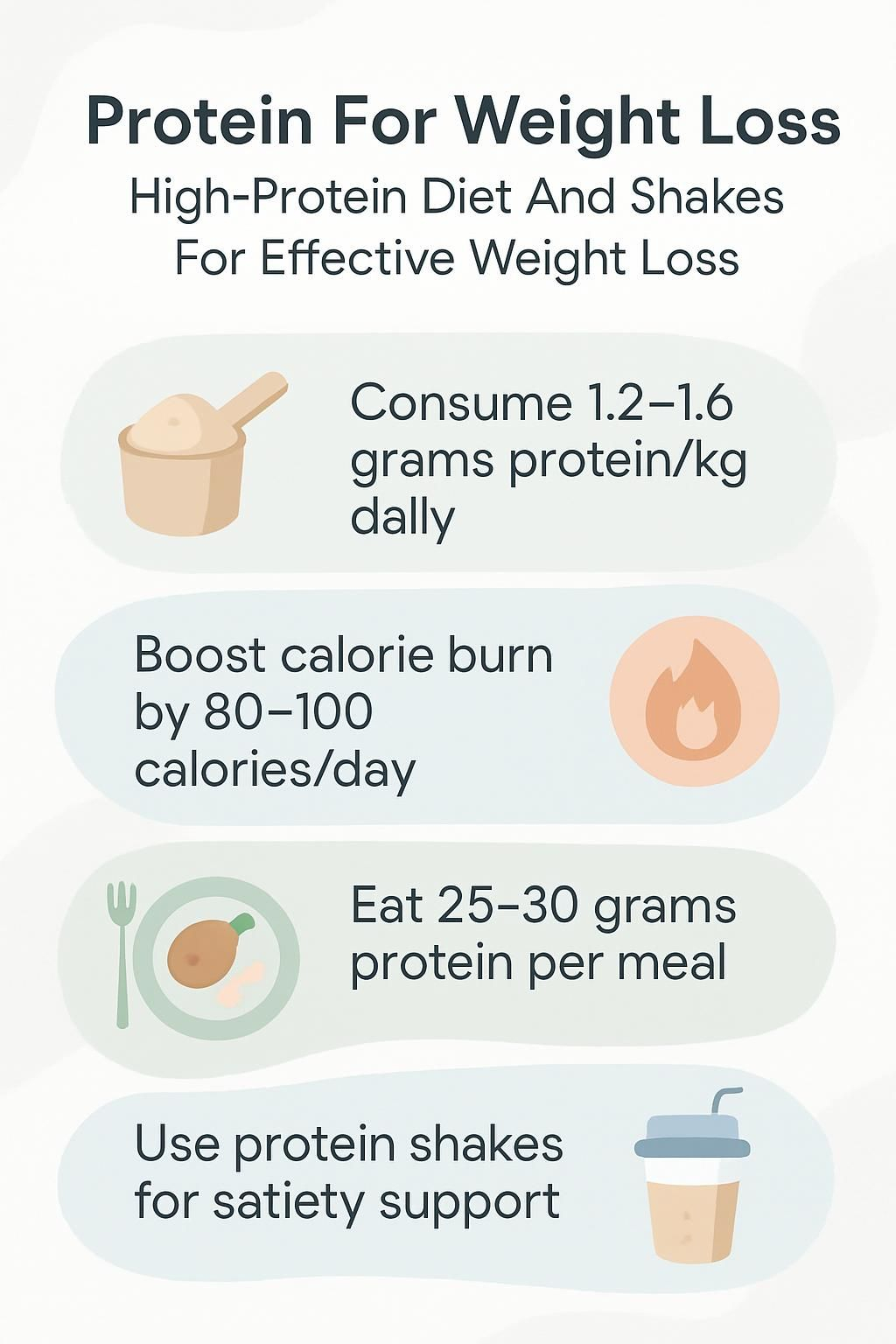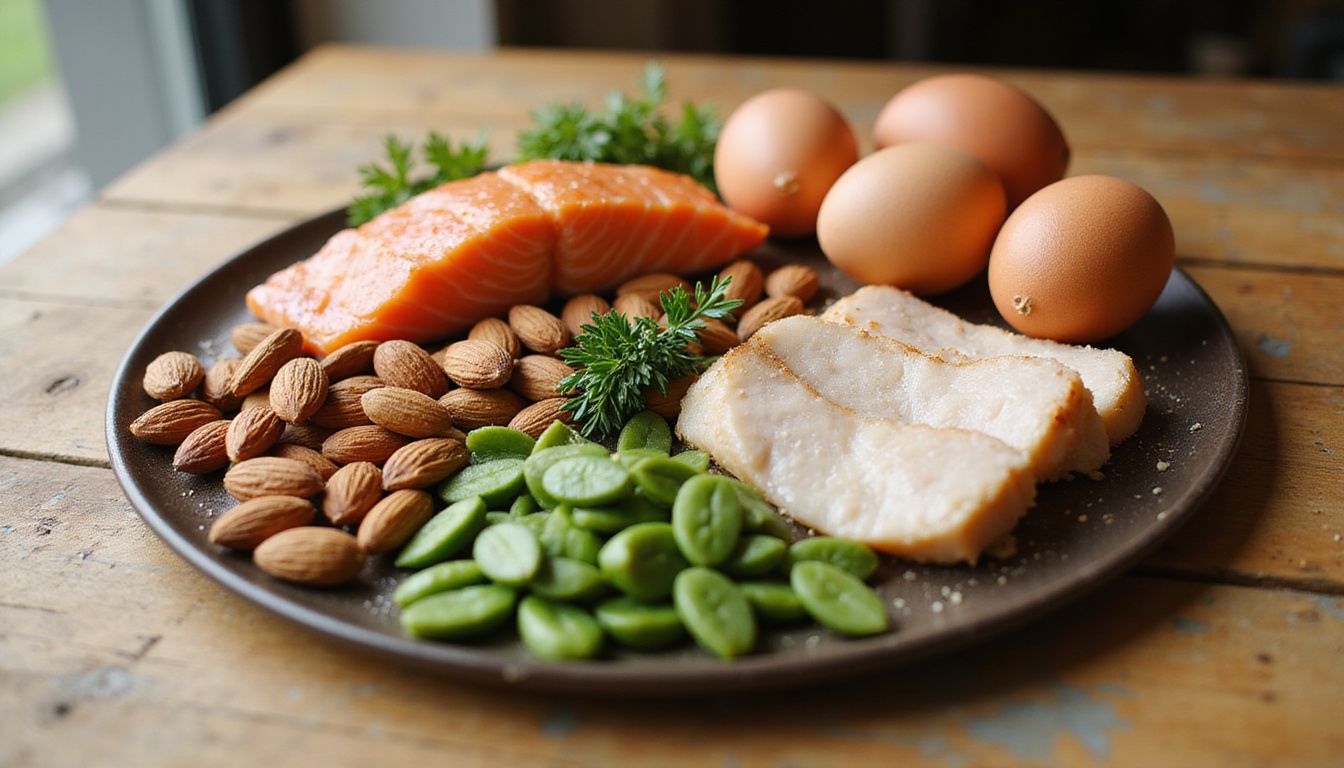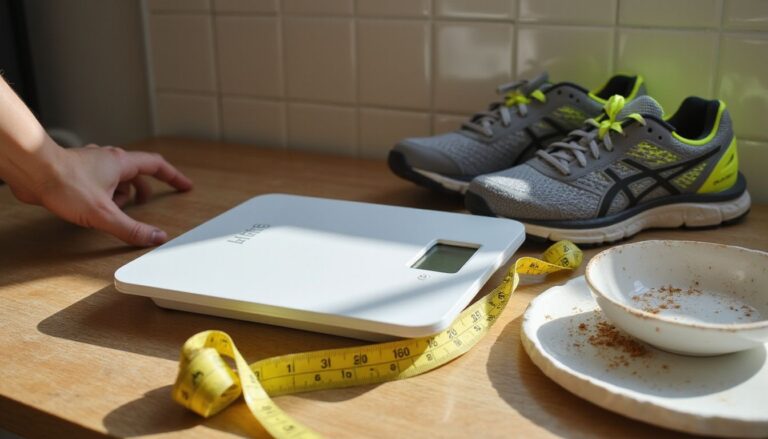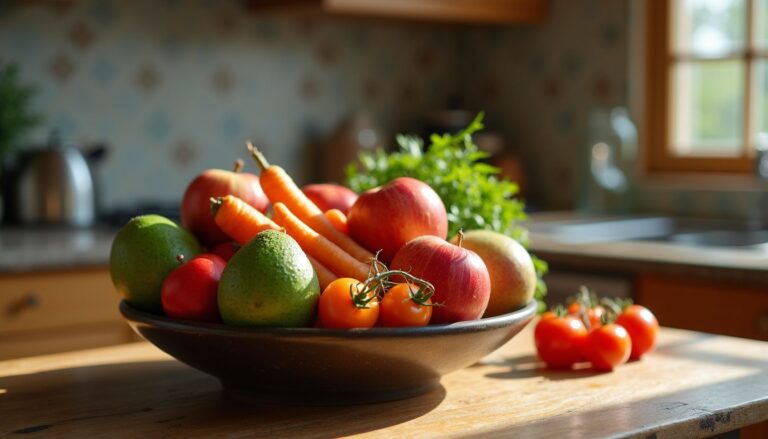Protein For Weight Loss: High-Protein Diet And Shakes For Effective Weight Loss
Our Nutrition Assistant AI Suite will transform your body. You will lose fat, get toned, and build muscle. Gain confidence and optimal health.
If you are trying to lose weight yet feel hungry all day, staying consistent gets tough. A high-protein diet can help. Extra protein may curb appetite and support a steady calorie burn, both of which aid weight loss.
This guide shows how protein supports healthy weight management, explains the science in simple terms, and covers safe daily targets. You will also learn smart ways to use protein shakes without losing balance in your diet.
Keep reading for practical tips you can use at your next meal.
Key Takeaways
- Aim for about 1.2 to 1.6 grams of protein per kilogram of body weight each day to reduce hunger and protect muscle during weight loss.
- Protein has a higher thermic effect of food than carbs or fat, which can add about 80 to 100 extra calories burned per day.
- Spreading 25 to 30 grams of protein at each meal improves fullness and supports long-term weight management.
- Protein shakes, such as whey or pea protein, can replace a snack or meal and help maintain muscle while you cut calories.
- If you have kidney disease, diabetes, or other medical conditions, talk with your clinician before starting a high-protein plan.

How Does Protein Help with Weight Loss?

Protein works on hunger, metabolism, and muscle. Think of it as the nutrient that keeps you satisfied while your body uses energy to digest it.
How does protein promote fullness and reduce hunger?
Protein lowers ghrelin, the hormone that signals hunger, and raises hormones like GLP-1 and PYY, which promote fullness. That is why eggs, chicken breast, fish, or Greek yogurt help you feel satisfied sooner and for longer.
Clinical studies report fewer cravings and less late-night snacking with higher protein intake. Many people do well targeting at least 30 grams of protein per meal to steady appetite through the day.
You may notice fewer between-meal snacks once you add lean protein to breakfast, lunch, and dinner. High-protein meals also make it easier to stick with your calorie plan.
How does protein boost metabolism and calorie burning?
Your body uses more energy to digest and process protein than it does for carbohydrates or fats. This is called the thermic effect of food. Protein’s thermic effect can add roughly 80 to 100 calories to your daily burn.
Research shows this small bump supports fat loss over time, especially when paired with calorie control. Many people also feel more alert after a protein-rich meal, which can help with daily activity.
Adding lean meats, fish, eggs, or plant proteins like lentils can raise this effect slightly while keeping meals filling and balanced. This helps you maintain progress without feeling deprived.
How does protein preserve muscle during weight loss?
During weight loss, you can lose muscle if protein intake is too low. Protein supplies amino acids, the building blocks your muscles need to repair and grow, even in a calorie deficit.
Higher protein helps protect lean body mass as you drop fat mass. Many dietitians suggest at least 1.2 grams of protein per kilogram of starting body weight per day, and even more if you lift weights or are older.
Sufficient dietary protein is a fundamental building block to preserve muscle health during calorie restriction.
Knowing what counts as a high-protein diet makes meal planning simpler and safer.
Understanding a High-Protein Diet for Weight Loss
A high-protein diet can help manage appetite, support muscle, and promote weight loss. The benefits come from both biology and habits, such as building meals around satisfying protein sources.
What is considered a high-protein diet?
Most experts define a high-protein pattern as 20 to 30 grams of quality protein at each meal, or about 1.2 to 1.6 grams per kilogram of body weight per day. Some people go higher, especially athletes, to protect muscle.
To reach these levels, include protein at every meal and snack. Options include lean meats, eggs, dairy, beans, lentils, tofu, and nuts or seeds. You can also use protein powder if food alone falls short.
People seeking weight loss or better muscle retention often follow this approach to improve fullness and regulate energy intake.
What are the benefits of a high-protein diet for losing weight?
Protein increases satiety, which helps you eat fewer calories. It also helps maintain muscle during weight loss. Since muscle burns more energy at rest than fat, this supports a higher daily burn.
Research from groups like the National Institutes of Health shows that higher protein intakes can improve body composition and make weight maintenance easier. Many randomized trials confirm these benefits for healthy adults.
Tracking your intake for a week can be eye opening. You often find that adding protein at breakfast and lunch cuts afternoon cravings and late-night snacking.
How much protein should I eat daily for weight loss?
Finding your daily target helps you lose fat while preserving muscle.
- Aim for 1.2 to 1.6 grams of protein per kilogram of body weight each day to support weight loss and muscle maintenance.
- If you weigh 150 pounds, about 68 kilograms, target roughly 81 to 109 grams per day.
- Try for 25 to 30 grams of protein at each meal to boost fullness and steady energy.
- Use a mix of foods: lean meats, eggs, dairy, legumes, tofu or tempeh, nuts, and seeds.
- If you have kidney disease or liver problems, get medical advice before raising protein.
- Protein supplements can help if whole foods are not enough. Whey, casein, pea, or soy are common choices.
- Consistent protein helps protect lean muscle while you lose fat, which supports a healthy metabolism.
- Pair protein with regular exercise, especially strength training, for best results.
- Consider your health history, such as type 2 diabetes, blood pressure, and medications, before major changes.
- Use a food log or app to track progress and meet your daily goals.
Logging meals for a few days can help you spot gaps and plan easy swaps, like Greek yogurt at breakfast or beans at lunch.
Best High-Protein Foods to Support Weight Loss
Many foods are naturally high in protein and fit well in a calorie deficit. Mix animal and plant sources to get a full range of nutrients.
Which lean meats are best for weight loss?
- Skinless chicken breast offers about 26 grams of protein per 3 ounces with very little fat.
- Turkey breast gives similar protein with fewer calories, so it is great for meal prep.
- Lean cuts of beef labeled loin or round, such as sirloin or eye of round, provide protein with less saturated fat.
- Pork tenderloin is low in fat and supplies a solid protein boost per serving.
- White fish like cod, tilapia, and haddock deliver 17 to 20 grams per 3 ounces with minimal fat.
- Salmon and other fatty fish supply protein plus omega-3 fats that support heart health.
- Ground meats that are 90 percent lean or higher can fit if portions and cooking methods are mindful.
Batch cooking chicken or turkey on weekends gives you quick, high-protein building blocks for the week.
What eggs and dairy products help with weight loss?
Eggs and dairy are budget friendly, easy to use, and keep you full.
- One large egg has 6 grams of protein and works for breakfast, lunch, or snacks.
- A half cup of low-fat cottage cheese provides about 12 grams of protein and pairs well with fruit or veggies.
- One ounce of provolone contains about 7 grams of protein, so use it to add flavor to wraps or salads.
- Four ounces of plain low-fat yogurt has roughly 6 grams of protein and offers calcium too.
- One cup of low-fat milk contains about 8 grams of protein and can round out a meal.
- Choosing lower fat dairy helps limit saturated fat while keeping meals satisfying.
These foods help you meet your protein goal, which protects muscle as you lose body fat.
Are plant-based proteins like beans, lentils, and tofu effective?
Plant proteins support weight loss and heart health. They also provide fiber, which improves fullness and digestion.
- Beans add protein and fiber. For example, a half cup of cooked kidney beans offers about 7 to 8 grams of protein.
- Lentils are rich in both protein and fiber, with about 9 grams per half cup cooked.
- Firm tofu gives about 9 grams per 3 ounces and is low in calories and saturated fat.
- Quinoa provides all essential amino acids, with about 8 grams per cup cooked.
- Legumes contain amino acids like leucine, which helps support muscle during weight loss.
- Diets rich in plant proteins can improve cholesterol levels and support liver health.
- Many people feel light yet full after meals built around lentils, beans, or tofu.
Plant-based proteins help you reach your protein target while adding fiber and micronutrients.
How do nuts and seeds contribute to protein intake?
Nuts and seeds add protein, healthy fats, and crunch. They are calorie dense, so measure portions.
- One ounce of almonds has about 6 grams of protein. Keep snack portions to a small handful.
- Two tablespoons of peanut butter provide roughly 7 grams of protein, while almond butter gives about 6 to 7 grams.
- Add walnuts or almonds to oatmeal or yogurt to raise protein and improve satisfaction.
- Nuts and seeds also supply omega-3 and omega-6 fatty acids that support heart health.
- Keeping snack packs on hand can reduce cravings better than sugary treats.
Combining high-protein foods with produce and whole grains builds meals that keep you full and on track.
Using Protein Shakes to Aid Weight Loss
Protein shakes are a convenient tool. They can help you hit your protein goal when time is tight or appetite is low.
What are the benefits of adding protein shakes to my diet?
Shakes deliver high-quality protein in one simple serving, which can support muscle repair and reduce hunger. Many people use them to replace a snack or a light meal during a calorie deficit.
Studies suggest that protein shakes can improve fullness and help maintain lean mass while you lose fat. They are also easy to portion, so you can control calories without guessing.
Choosing a shake lets you get protein without extra saturated fat. You can still keep carbs from whole grains, fruits, and vegetables for energy and fiber.
What types of protein shakes are available?
- Whey protein comes from milk, includes all essential amino acids, and absorbs quickly to support recovery.
- Casein also comes from milk but digests slowly, which helps control hunger between meals or overnight.
- Soy protein is a complete plant protein that supports muscle and suits people who avoid dairy.
- Pea protein is dairy free and rich in branched-chain amino acids that aid recovery and satiety.
- Rice protein is gentle on the stomach. Combine with pea protein for a more complete amino acid profile.
- Egg-white protein is low in fat and lactose free, and it digests quickly.
- Hemp or broth-based options add minerals along with moderate protein.
- Ready-to-drink meal replacement shakes are useful on busy days if you watch sugars and calories.
Pick a powder based on your needs, taste, digestion, and any allergies. Many people test small tubs or single-serve packs before buying in bulk.
How can I use protein shakes effectively for weight loss?
Use shakes as a structured part of your plan, not an extra on top of your usual intake.
- Replace a meal or snack with a shake instead of adding it to your day.
- Aim for 20 to 30 grams of protein per serving to support fullness and muscle.
- Add fiber or healthy fats, such as chia seeds or peanut butter, to slow digestion.
- Have a shake after workouts to aid recovery if you struggle to eat a full meal.
- Track your daily protein to avoid going far above your target.
- Choose products with minimal added sugars and short ingredient lists.
- Set a routine time, like breakfast or post-exercise, to spread protein across the day.
- If you have kidney disease or other medical issues, talk with your clinician first.
Next, explore the protein types found in shakes to match your goals and preferences.
Different Types of Protein Found in Shakes
Each protein type has a small advantage. Pick the one that suits your goals, taste, and digestion.
What is whey protein and its benefits?
Whey is a complete milk protein that digests fast. It supports muscle repair after exercise and can help reduce fat mass when calories are controlled.
Whey may increase fullness hormones while reducing ghrelin, which helps manage hunger. Many people find an afternoon whey shake stops grazing until dinner.
Select a reputable brand that lists protein content clearly and has third-party testing when possible.
How does casein protein work for weight loss?
Casein digests slowly and feeds muscles over several hours. It is also a complete protein from milk.
Studies show casein can increase fullness more than some plant proteins, which makes it useful before bed or during long gaps between meals. Over time, casein and whey show similar weight outcomes if calories and protein are matched.
A bedtime casein shake can reduce late-night snacking and support overnight recovery.
Is soy protein effective for weight loss?
Soy is a complete plant protein with a solid amino acid profile. The weight loss effect is similar to other proteins when total calories and protein are the same.
If you prefer plant-based options, soy is a practical choice in shakes or foods like tofu and edamame. Rotate with other sources to add variety and support a balanced diet.
What are the advantages of pea protein?
Pea protein is dairy free and well tolerated by many people. It provides all essential amino acids and supports fullness.
Early research suggests pea protein can aid body composition when paired with training and calorie control. It is a strong option for those who avoid lactose or follow a plant-based pattern.
Many people use pea protein to stay satisfied between meals and to recover after workouts without stomach upset.
How does rice protein compare to other types?
Rice protein is easy on digestion but is lower in lysine on its own. Mixing rice with pea protein improves the amino acid profile.
Small studies in active people show improvements in muscle and body composition when rice protein is used consistently. It is also lactose free and vegan friendly.
Try blends that combine rice and pea to cover your amino acid needs while keeping shakes smooth and mild in flavor.
Combining Protein with Fiber and Healthy Fats
Protein does the heavy lifting for fullness, but fiber and healthy fats help it last. Think of them as the support team.
Why is fiber important when eating protein?
Higher protein with low fiber can lead to constipation. Fiber from beans, lentils, fruits, vegetables, and whole grains keeps digestion on track and extends fullness.
Research shows that raising fiber helps people feel satisfied after meals and better manage body weight. Adding a side salad, roasted vegetables, or berries to a protein-rich meal is a simple fix.
Balance both nutrients daily for comfort and consistency.
How do balanced meals with protein provide sustained energy?
Meals that include protein, fiber, and healthy fats digest more slowly. This helps avoid sharp spikes and drops in blood sugar that can cause fatigue and hunger.
For example, pair grilled chicken with brown rice and avocado, or scrambled eggs with whole-grain toast and peanut butter. Spreading protein across the day keeps energy steady and supports muscle maintenance.
You will likely snack less and feel focused longer after a balanced meal.
Is Eating a High-Protein Diet Safe?
For most healthy adults, a high-protein diet is safe in the short term. You still need a balanced intake that includes fruits, vegetables, whole grains, and healthy fats.
What are the risks of eating too much protein?
Very high protein intakes can lead to headaches, bad breath, constipation, or nutrient gaps if carbs and fiber are too low. Diets heavy in fatty meats can raise LDL cholesterol, which increases heart risk.
Excessive protein may stress the kidneys in people with kidney disease. If you have a medical condition, ask your healthcare professional about a safe range before you make big changes.
How can I safely increase my protein intake?
Build up gradually so your body and routine adjust smoothly.
- Add a small protein serving to each meal for one week, such as eggs at breakfast or grilled chicken at lunch.
- Choose lean meats like chicken, turkey, or fish to limit saturated fat.
- Include plant proteins like beans, lentils, tofu, and edamame several times per week.
- Use low-fat dairy like Greek yogurt or cottage cheese for extra protein.
- Snack on nuts and seeds in measured portions for protein and healthy fats.
- Spread protein across the day instead of loading it all at dinner.
- Use a quality protein shake if whole foods are not enough.
- Read labels to pick higher protein foods with lower added sugars.
- Increase intake step by step to avoid digestive discomfort.
Consistent protein across meals supports muscle protection and stable energy during weight loss.
Who should talk to a doctor before starting a high-protein diet?
If you have kidney disease, diabetes, liver disease, or take medications that affect the kidneys, talk with your doctor or a registered dietitian first. Medical guidance helps you set a safe protein range.
Anyone with a chronic condition, older adults, and people recovering from illness should also seek advice. A quick consult can prevent setbacks and support steady progress.
How Can I Increase My Protein Intake?
Small changes add up. Focus on steady habits that fit your lifestyle.
Why should I spread protein throughout the day?
Evenly spaced protein improves fullness and supports muscle maintenance. Research suggests that 20 to 30 grams at each meal works better than saving most protein for dinner.
For example, you could use eggs or Greek yogurt at breakfast, chicken or beans at lunch, and fish or tofu at dinner. This structure often reduces cravings and late-night snacking.
It also helps you recover better from workouts and keeps energy steady.
What are good protein-rich snacks?
Snacks can bridge the gap between meals and help you reach your daily protein goal.
- Half cup low-fat cottage cheese, about 12 grams of protein.
- One ounce of almonds, roughly 6 grams of protein.
- Two tablespoons of peanut butter, around 7 grams of protein, on apple slices or toast.
- Four ounces of Greek yogurt, about 6 grams of protein, with berries.
- One large hard-boiled egg, 6 grams of protein.
- Roasted chickpeas for a crunchy, high-fiber plant snack.
- Turkey or chicken breast roll-ups for lean protein with fewer additives.
- Edamame, about 17 grams per cup, which is a strong plant-based option.
- Part-skim string cheese, usually 6 to 7 grams of protein.
- A smoothie with protein powder and milk or water for a quick boost.
Keeping two ready snacks on hand during busy days can prevent last-minute high-calorie choices.
When should I consider using protein supplements?
If you struggle to meet your target through food, a supplement can help. This is common during weight loss, in heavy training periods, or for older adults with lower appetite.
Use a shake as a meal or snack replacement rather than an add-on if you are watching calories. Many people find that a balanced breakfast shake keeps them full until lunch and improves appetite control.
If you are unsure which product to choose, start with a sample size and see how you feel after a week. Look for third-party tested products for quality.
Frequently Asked Questions about Protein and Weight Loss
Here are quick answers to common questions. Use them to fine-tune your plan.
Can I lose weight by eating protein alone?
Higher protein helps with fullness and may raise calorie burn slightly. It also protects muscle during weight loss.
But your body needs balance. Carbohydrates fuel activity, and healthy fats support hormones and vitamin absorption. Very high protein with very low fiber can backfire and reduce energy.
Build meals with protein, colorful produce, whole grains, and healthy fats for the best results.
How much protein do I need each day?
Most people aiming for fat loss do well with 1.2 to 1.6 grams per kilogram of body weight each day. If you weigh 150 pounds, about 68 kilograms, that is roughly 81 to 109 grams daily.
Hit your goal by including a protein source at every meal or snack. Greek yogurt in the morning and chicken or bean chili at lunch can move you closer to your target without big changes.
Adjust as needed based on your hunger, training, and check-ins with a healthcare professional.
Are plant-based proteins as effective as animal proteins for weight loss?
Yes. When total protein and calories match, plant and animal proteins support weight loss and appetite control similarly. Plant proteins add fiber, which boosts fullness and supports heart health.
Eating a variety of plant proteins, such as beans, lentils, tofu, and quinoa, can provide all essential amino acids over the day. Many people feel satisfied longer after plant-forward meals that include protein and fiber.
Choose the sources that fit your values, digestion, and taste, then keep protein steady at each meal.
Conclusion
A high-protein diet for weight loss can tame hunger, support muscle, and slightly raise daily calorie burn. Fill your plate with chicken, fish, eggs, yogurt, tofu, beans, and lentils. Use protein shakes when food alone is not enough.
Keep meals balanced with fiber and healthy fats for steady energy. Most healthy adults can follow this approach safely. If you have kidney disease, diabetes, or other conditions, get medical advice first.
With a clear plan and small daily steps, higher protein can help you reach and maintain a healthy weight.
Sources for further reading: National Institutes of Health, Academy of Nutrition and Dietetics, and randomized trials on high-protein diets and weight management.
FAQs
1. How does a high-protein eating plan help with weight loss?
A high-protein eating plan helps reduce hunger and supports muscle retention during calorie restriction. Research shows that protein increases satiety, which can lead to lower overall calorie intake. For example, one study found people who ate more protein lost more body fat than those on standard diets (Leidy et al., 2015).
2. What are the best sources of protein for effective weight management?
Lean meats like chicken breast, turkey, and fish provide concentrated protein with fewer calories from fat. Eggs, Greek yogurt, cottage cheese, tofu, lentils, and beans also offer quality options for varied preferences.
3. Are meal replacement shakes with added protein useful for losing weight?
Meal replacement shakes containing whey or plant-based proteins can support structured eating patterns by controlling portion size and providing consistent nutrition. In clinical trials published in Obesity Reviews (2018), participants using these shakes experienced greater short-term weight reduction compared to traditional food-only approaches.
4. Can increasing dietary protein cause health risks when trying to lose weight?
Most healthy adults tolerate higher dietary protein without harm if kidney function is normal; however, very high intakes may stress kidneys in those with pre-existing conditions (Martin et al., 2005). It is important to balance total nutrient intake while following a high-protein regimen.
Summary: High-protein diets promote fullness and preserve lean mass during energy restriction; top sources include lean meats and dairy alternatives as well as legumes; meal replacement shakes offer convenience backed by research; most individuals benefit safely but should monitor health status throughout their journey toward effective weight control.







